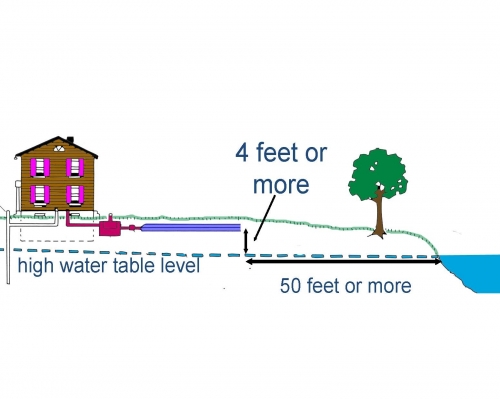Alternatives to conventional septic systems to treat on-site wastewater
Riparians who depend on on-site wastewater treatment may need to look to an alternative septic system to properly protect water quality.
Michigan abounds with an amazing number of inland lakes, rivers and streams. Riparians, or individuals who live on or near water, often experience multiple challenges associated with on-site-wastewater treatment.
Many of these homes and their wastewater treatment systems may have initially been designed to serve as a seasonal “cottage” and, at some point, were converted into year-round residences without any upgrade to their wastewater treatment systems. As a result, the system may not be big enough to process the amount of wastewater being generated, leading to the need to pump more frequently and/or premature demise of the system.
In addition, native plants and wetlands may have been replaced with lawns, beaches and seawalls, and thus pollutants have less opportunity to be filtered thoroughly before reaching the water. Shoreline erosion can also shorten the distance between the septic system and the water’s edge. Loss of shoreline may lead to inadequate area to properly treat wastewater before it moves into surface water and/or groundwater. Ideally, septic system isolation distance call for a minimum of 50 feet from the end of the drainfield to the edge of adjacent surface water and four feet between the bottom of the drainfield and the water table to ensure wastewater is adequately treated.
Figure 1: Illustration of acceptable septic system isolation distances
In sensitive shoreline areas, adequate soil area/depth, soil type and nearness to both groundwater and surface water are significant factors that can increase the risk of potential contamination from shoreline septic systems and which can lead to ineffective subsurface wastewater treatment.
Along many shorelines, homes are so close to each other that the disposal system does not have a large enough area/depth to adequately process the wastewater generated. Very sandy soils may allow nutrients to move too quickly down to groundwater before they are properly processed in the soil.
In contrast, a drainfield that contains heavy (clay) soils is at greater risk for clogging and failing, causing contaminants and nutrients to bubble up to the surface and potentially run off the shore and into nearby surface water. With regard to nearness to both groundwater and surface water, because shoreline areas typically have high water tables and septic systems are often very close to the water, the potential to negatively impact groundwater and/or surface water under these conditions is significant.
For residents of some riparian areas, an alternative disposal method can offer cost-effective, long-term solutions to water quality problems caused by septic systems if soil or site conditions are not suitable for a conventional drainfield:
In a mound system, the drainfield is elevated to provide additional soil depth for treatment. If your system has to be on the lake or stream side of the house, the health department may permit a mound system to increase the distance between the drainfield pipes and the water table.
A sand filter has layers of sand and gravel in which the wastewater is treated before it is distributed into the existing soil. These alternative systems may require a pump or siphon to send even doses of effluent into the distribution system.
Aerobic treatment units mix wastewater with air on surfaces where bacteria can feed on the organic wastes and pathogens. Aerobic tanks are used in place of septic tanks, most often at sites that do not have adequate soil area or depth for effective subsurface wastewater treatment.
Holding tanks, though generally not recommended, may be used in temporary situations prior to a new system hookup or at summer residences. In contrast to a septic tank, a holding tank has no outlet and must be pumped frequently to dispose of wastewater.
It is important to note that the use of these alternative systems is restricted by local health department codes and requires design and construction by experienced engineers and contractors. Servicing requirements for these systems vary and should be obtained from your local sanitarian or septic system contractor.
To find out more about these alternative systems and other community sewage system options for your area such as a multiple-home “cluster” septic system which utilizes one system to service wastewater from more than one home, contact your local health department or township board.
“Managing Your Septic System (WQ-39)” provides additional information regarding on-site wastewater treatment. An excellent resource to help determine your risk of contributing to shoreline contamination is the Michigan State University (MSU) Extension bulletin “Managing Shoreline Property to Protect Water Quality (WQ-52).” The “Home*A*Syst Guide (WQ-51)” can also help assess your potential for environmental risks in and around your home.
All are available through the MSU Extension Bookstore.
Related MSU Extension articles:



 Print
Print Email
Email



